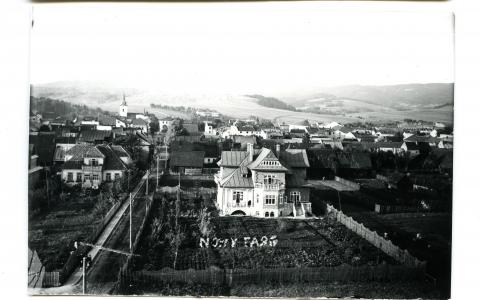|
Edward Morawetz willingly captured the town from the southern side, directing his photographic lens toward the Gorce Mountains. In the photo dating back to 1935 (the photo from the A. Nowak’s collection), taken from the Church that was being built at that time, we can see the panorama of the town against a background of mild slopes in the Kokoszkowo and Dział districts which are crossed by fields grown by industrious farmers of Nowy Targ. On the foreground, there are presented magnificent, suburban villas with large gardens and Kazimierza Wielkiego Street with its pavement leading to the Main Square. A main square of a town is always center of life. This is actually the place where the roads, connecting a town with some distant places, cross each other. This is the place, where the best shops, restaurants, official residences, banks and hotels are located. And this is the place where people meet each other, walk and talk, where children like to play and where important events and ceremonies take place. In Nowy Targ, the quadrangular, spacious main square demarcated during the location of the town in 1346, had been staying the same since the Middle Ages. |
It was surrounded mostly by one-storeyed, wooden buildings. After the fire in 1784, which destroyed the town almost completely, the foremen and baron Tschirich von Siegsteten delegated the great Austrian engineer Carl von Hoffner to prepare the new plan of spatial regulation in Nowy Targ. The city center that he planned, basing on Kazimierzow spatial location of the main square and on the quadrangular town houses situated among streets crossing each other on the square, exists unchanged till now. Moreover, there was the order given by the authorities that only brick houses can be built. At the beginning of the 20th century, the main square was surrounded by the congested housing constituted mainly by storeyed town houses. The whole square was paved and around the houses, there were pavements made of plates. Along those houses, the trees were growing: in the subsequent photos, it can be seen, as they were becoming bigger and bigger. The religiousness of the local Catholics and Jews is proved by the presence of temples which close symbolically the perspective of the two opposite corners: the northern-west corner is dominated by the magnificent tower of St. Katherine Church with its baroque bell-tower and the southern-east corner by the regular facade of the main synagogue (Photos No. 394, 536, 286). In the centre of the Main Square, there is the brick, storeyed Town Hall with the clock tower developed in the years 1889-1890 (Photo No. 488, 528, 398, 399). Within the stone’s throw, there is the St. John chapel, together with the pump of the town well. And basically that is all; the main square of the town stayed the open space that was sleepy and empty and coming alive only during some important event when all the inhabitants of Nowy Targ gathered there filling it with their noisy presence. During the village fairs that took place every week, the Main Square became the scene of a vivid, noisy show with horse-drawn carriages and stalls belonging to craftsmen and merchants placed in a particular order according to the orders of local authorities and with crowds of Jews and mountaineers coming from the neighboring villages. |


